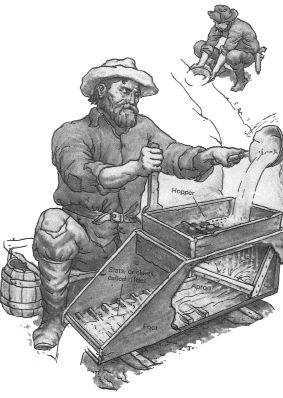
Discover rewarding casino experiences. 

Please Don't Quote Me PART V — Franklin Langworthy, late of Mt. Carroll, wrote a book concerning the Carroll County ‘49ers “and their trips to the Gold Rush. It apparently, is among the rarest of the rare. Who has read it?” Scenery of the Plains, Mountains and Mines, a diary. Report of the Overland Route to California by way of the Great Salt Lake. Travels in the Cities, Mines Agricultural Districts Embracing the Return by the Pacific Ocean and Central America in the years 1850, 1851, 1852, 1853.” And that was merely the title page, not a condensed version of the story! |
It was published in 1855 at Ogdensburg by J.C. Sprague of the Gold Rush days and the thousands who went West from the “States” to the Pacific Coast heretofore too distant for most to realize. However, by the mid-1840s the U.S. Government was using the military as a tactic to remove Mexicans from ranches, forts and missions as it could see even before the mineral finds, that the coastal territories were of great value to the “States.” It was the period of the Mexican War, remember, but of which we hear little though several settlers here had entered into it. (Heard of Buena Vista in Stephenson County? Was it connected?) When the gold strikes occurred late in 1848 they strengthened United States’ resolve to possess the Far West contiguously! One of Langworthy’s observations was that a high percentage of those going West were professional men ... “At least ten percent claimed to be a doctor. There were many counsellors at law, preachers of all denominations, any amount of generals and judges.” He related of the extreme difficulties of persuading the ox teams to cross the freezing cold rivers (there was snow to travel through yet in June). There were no bridges and only a few ferries but drivers still had to wade in deep, chill waters to goad the oxen into the streams. Thousands of pieces of furniture and household goods were strewn beside the trails, dead animals (and humans). People dead from disease, lost hope, starvation or killed, as before mentioned. Wagons and goods were burned for fire, for heat and cooking, what little was available, “property worth a $100 bill in the States would be added to the fire!” Franklin Langworthy was in California about two years and because of frail health found he was unable to do any mining so he made money by giving a lecture series of “popular” scientific subjects. “Like many another, he’d discovered there was more than one way to make a living in the Gold Rush. (One Carroll Countian raised potatoes, don’t you know.)
A quote of Langworthy’s was, “In undertaking this hazardousenterprise to gain a competency in worldly goods, I was not alone and neither was I singular in failing in that objective!” We do not know how many countians stayed in the West or how many returned, neither do we know if any were successful at gold fining. But the changes here while they were gone were quite noticeable, according to Langworthy. By 1854 when he’d settled here again, he’d written that Mt. Carroll was a flourishing village of about 800, double in size to what it had been when he left. There was a stone courthouse, three churches, an academy (Shimer), a common school, a flourishing flour mill with steam and water power, an iron foundry and other manufactories. Like many another, he’d made the return journey via the Pacific and Central America to New York, then up the Hudson to Niagra Falls and to Chicago which he predicted “would grow from its present 70,000 to become the greatest emporium of the West.” He also reported on a pair of locals who were typical of returnees, one who’d discovered no riches in the West and had also lost a long-time sweetheart to another man because he’d been gone too long. The other, however, had a vest-ful of gold dust and Spanish doubloons, wore a broadcloth cape and a gold nugget in a tie pin with all kinds of lovely women chasing after him. Though in that case, the percentage was fifty-fifty for “winners,” it’s doubtful it was that successful in “real life.” An interesting inclusion in the brief mention of the Gold Rush in the County history of Northwest Illinois is that again it’s found that once a frontiersman always a frontiersman as typified by the first settlers of Savanna in the person of Vance Davidson, and a little later comer, Bob Upton. In 1828 Aaron and Harriet Pierce, their four children, George Davidson and wife; Vance Davidson, William Blundell and wife (daughter of George D.), had roped down the bluff above the sandy beach which became the Plum River settlement, Carrollport, then Savanna. They’d lived in a large Indian council house until their cabins were built. They’d made sporadic stops and starts before that but settled here for nearly twenty years which you’d have thought was permanent. But Vance Davidson still had that frontier itch and was with the first party from Carroll County to start for the Gold Rush in 1849. He returned the next year gathered his wife and family and with a large party of about twenty (who are listed) to go West, this time to settle in, and as far as is known, were permanent Westerners. Vance was elected Captain of the party and a leader then as previously. They, however, it was said, “endured the hardships and privations” of all who went. By scanning some of the county newspapers we might find scattered bits of news of those who migrated West but author of the 1913 county history, C.L. Hostetter only relates that in after years, into the twentieth century, several hundred northern Illinoisans were gathering annually in Los Angeles to share their observations and experiences, refresh acquaintances, reminisce as all such “clubs” would do. These were a common occurrence for many decades following the assorted and varied exodus’ West. Did Bob Upton ever show up for roll call? Hopefully, you’ll recall Upton’s introduction at the beginning of this series. A “noted character,” as he was always referred to who had joined the Savanna settlement a few months after its beginning. It was he for whom “Upton’s Cave” at the Palisades Park was named for an incident in the BlackHawk War. A book should have been written about him had there been enough material. He was an individual whose building block in our settlement was special but we can only mention him here briefly. When he joined the settlement at Plum River it was said he was a dispatch runner for General Kearny at the fort at Rock Island, that in 1829. He was a sometime miner and trapper, a man of frontier knowledge, humor and deeds. And to be truthful, sometimes of “intemperate habits!” He, too, was among the first group in 1849 to go to the Gold Rush and like the others, “nothing more is known of him.” Would a census record in California have his name, the “Carroll County club roll call? A military payroll?”
Stephen Kearny by the late forties was a Brigadier General who’d just been appointed to head of the Army of the West, an incident that just may have disappointed John C. Fremont who’d been in California for some time and as history relates, “was intent on glory.” Kearny’s men made a forced march across the western territories to enter California and subdue the Mexican armies. It’s a complicated chapter and coincidental with the Mexican War we hear about in old John Wayne movies!! The California territory was “cleared up,” land and sea, with the aid of Kearny’s arrival. Do you find it believable that Bob Upton would have gone to Gen. Kearny, his acquaintance from Rock Island to see if a dispatch runner was needed on a New Frontier?
|




